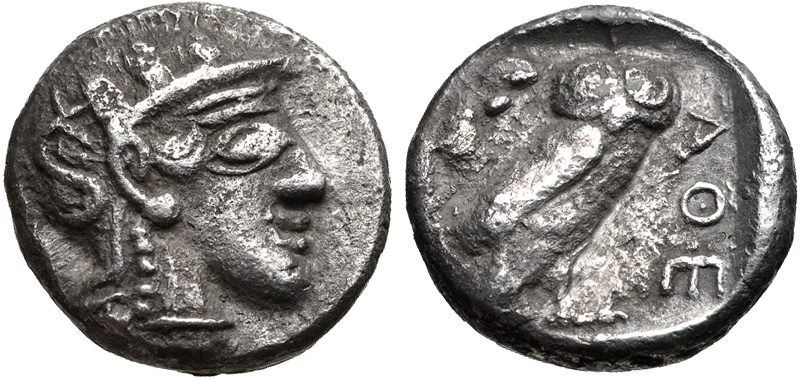Ashdod, silver, drachms (450-333 BCE)
From SILVER
450 BCE - 333 BCE Silver 1,838 kg
Description
| ObverseInscription or printing placed on the obverse.: | Helmeted head of Athena right, with frontal eye |
| ReverseInscription or printing placed on the reverse.: | Owl standing right, head facing, olive sprig and crescent behind, all within incuse square |
Mint and issuing power
| MintIdentifies the place of manufacture or issue of a numismatic object.: | Ashdod | Ancient regionAncient region.: | Judaea | Modern countryModern country: Israel | AuthorityIdentifies the issuing power. The authority can be "pretended" when the name or the portrait of X is on the coin but he/she was not the issuing power. It can also be "uncertain" when there is no mention of X on the coin but he/she was the issuing power according to the historical sources: |
Chronology
| FromIdentifies the initial date in a range assigned in a numismatic context. | 450 BCE | toIdentifies the final date in a range assigned in a numismatic context.. | 333 BCE | PeriodTime period of the numismatic object.: Classical 480-323 BC |
Physical description
| MetalThe physical material (usually metal) from which an object is made.: | Silver |
Median weightMedian of the weights of numismatic objects (in grams). in grams | 3.80 | DenominationTerm indicating the value of a numismatic object. Examples: tetradrachm, chalkous, denarius.: | drachma |
StandardStandard.: |
Image

S2115 Ashdod drachms.jpg [1]
References
| Die study referencePublication of the study: | Gitler - Tal 20061Gitler - Tal 2006, p. 76-93 | ||
| Coin series referenceReference to coin series study: | HGC 102HGC 10, n° 465 | ||
| Coin series web referenceCoin series web references: | |||
Obverse dies distribution
| FrequencyFrequency of specimen in distribution. ᵖ | Number of obversesNumber of obverse dies. ᵖ (o) | % (o) | Number of coinsNumber of coins. (n) | % (n) | Die nameName(s) of the die(s). |
| 1 | 6 | 46.15 | 6 | 26.09 | 1P, 2P, 4P, 7P, 9P, 10P |
| 2 | 4 | 30.77 | 8 | 34.78 | 1A, 2A, 6P, 8P |
| 3 | 3 | 23.08 | 9 | 39.13 | 3P, 5P, 11P |
| Total | 13 of 13 | 100 | 23 of 23 | 100 |
Reverse dies distribution
no distribution is available
Quantification
| Number of obversesNumber of obverse dies. ᵖ (o) | 13 | Number of singletons (o1)The number of singleton coins. ᵖ | 6 |
| Number of reverse diesNumber of reverse dies. (r) | Number of coinsNumber of coins. (n) | 23 | |
| Coins per obverse dieNumber of coins per obverse die. (n/o) | 1.77 | Coins per reverse dieNumber of coins per reverse die. (n/r) | |
| Reverse per obverse ratioRatio of obverse dies divided by reverse dies. (r/o) | Percentage of singletons (o1)number of coins (n) divided by the number of singletons (o1) ᵖ | 46.15 % | |
| Original number of dies (O) (Carter 1983 formula)The estimation of the number of coins according to Carter 1983 ᵖ | 24.19 | Coins struck if 20,000 as average productivity per dieCoins made if the average productivity for obverses (according to Carter) is 20,000. ᵖ | 483,800 |
| Original number of dies (O) (Esty 2011 formula)The estimation of the number of coins according to the singleton formula in Esty 2011 ᵖ (O) | 29.9 | Survival rate if 20,000 as average productivity per dieSurvival rate if average productivity is 20,000. ᵖ | 0.00005 |
| Coverage (o = % of O) (Esty 1984 formula)Esty 1984 - coverage (% of O) ᵖ (o = % of O) | 73.91% | Die productivity if survival rate 1/2,000Average productivity if survival rate is 1/2,000. ᵖ | 1,901.61 |
| Weight of silver (in kg) if 20,000 coins per die (O = Carter formula)Carter 1983 * Median weight * 20000 (*10 if gold or electrum) ᵖ | 1,838 kg <br /> 1,838 kg | Die productivity if survival rate 1/5,000Average productivity if survival rate is 1/5,000. ᵖ | 4,754.03 |
Remarks
Most likely one single workstation A is for "Athenian style"; P is for "Philistian style"
References
- ^ Gitler, Haim - Tal, Oren (2006), The Coinage of Philistia of the Fifth and Fourth Centuries BC. A Study of the Earliest Coins of Palestine, Collezioni Numismatiche 6, Milan
- ^ Hoover, Oliver D. (2010), The Handbook of Greek Coinage Series. 10. handbook of coins of the Southern Levant : Phoenicia, southern Koile Syria (including Judaea), and Arabia, Lancaster-London, lxxix, 201 p.